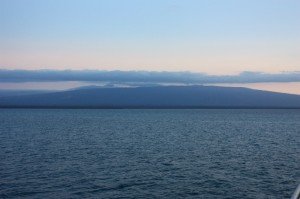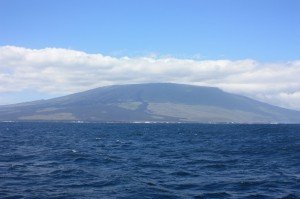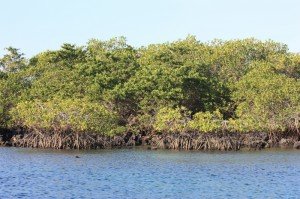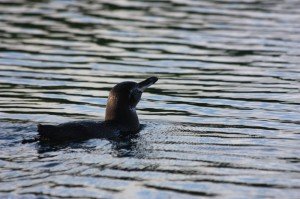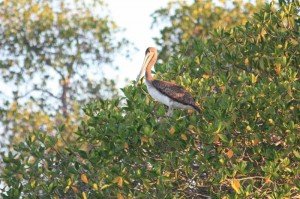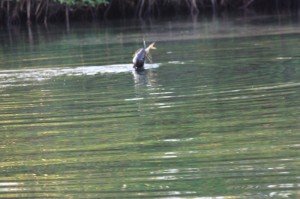Galapagos Adventure—Day 10
We spent most of yesterday traveling around the island of Isabela and taking it easy on the boat. The movement of the boat made me seasick in the morning, so I spent most of it in bed. But by 11:00 AM the waters had calmed, and so did the movement of the boat and I did well the rest of the day. When the boat stopped and we looked around we were essentially surrounded by active volcanoes. We can see Sierra Negra, the volcano we climbed the other day. We were again reminded of its large size, as we had been traveling for eight hours by boat and it was still in view! Three other volcanoes also come into view—Cerro Azul and Cerro Ballena on Isabela and the island of Fernandina, which is the youngest of the Galapagos Islands and essentially one giant volcano called La Cumbre. The naturalist tells us that all have erupted in the past several years.
Late in the afternoon, we cruise in pangas through Elizabeth Bay (Isabela). This is a long, narrow bay lined with white, black, and red mangroves. I found it ironic that this bay has the same name as my daughter and is known for its population of Galapagos penguins—and penguins are my daughter’s favorite bird. I make sure to take lots of pictures of the two penguins we spot swimming in the water. We also see some brown pelicans resting in the mangroves. It is very quiet and peaceful in the bay and we are the only ship for many miles.
This area is a favorite of Galapagos green turtles, and we see many of them. Because they are underwater, it’s difficult to get a good picture. We also see a Hawksbill turtle, which according to our naturalist, we are “lucky” to see.
Several sea lions join us swimming near the panga. In the distance we can see a sea lion thrashing about in the water. As we get closer, we discover it is playing with a fish it caught. Our naturalist says they usually play with the fish before they eat it. I think the term “sea lion” is a very appropriate name because they seem to be the “cats” of the marine world. They lie around much of the day on the beach in the sun, and they play with their food before they eat it—just like cats! Another sea lion and a frigate bird (known for their kleptoparasitic behavior) try to steal the fish. But the sea lion that had the fish first prevails, and we watch as he swallows it whole. The pictures I took turned out a little fuzzy, but it’s not easy to take pictures of a moving object when you’re sitting in a moving panga!
Soon the panga ride is over and we head back to the boat for dinner. After dinner we head to the sun deck, and Mr. Smith—one of the parents in our group—shares with us his astronomy knowledge. There is no light pollution here, we are the only boat in the area, and there is no moon, so the view of the evening sky is breathtaking. Dr. Lisle would love it! The Milky Way is clearly seen, and we also see Saturn and the Southern Cross. I even spot a shooting star! The phrase “. . . and the stars” in Genesis 1:16, which tells of God’s creation of the stars, doesn’t seem adequate to express the beauty of this night sky. Mr. Smith also has a nifty device called a Sky Scout. It uses a built in GPS to determine your latitude and longitude (we are near the equator now). You then point it at a star of interest, center it, press the button, and it identifies the star and tells you information about it—like how many light years away it is. Now that I’ve used it, I want one!
All of us were glad for a day of rest and are ready for more adventure tomorrow. We will visit Fernandina today and hope to see the flightless cormorant, penguins, and marine iguanas. Enjoy the pix!

Answers in Genesis is an apologetics ministry, dedicated to helping Christians defend their faith and proclaim the good news of Jesus Christ.
- Customer Service 800.778.3390
- Available Monday–Friday | 9 AM–5 PM ET
- © 2025 Answers in Genesis


